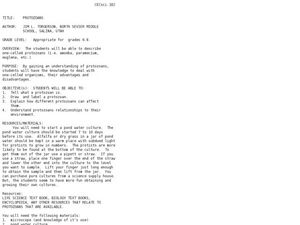Curated OER
Protists - The Protozoans
Five pages provide thorough coverage of three protozoans: euglena, amoebae, and paramecia. For each, junior biologists read factual text, label the organism, and write answers to several questions. This neatly organized assignment is...
Curated OER
PARAMECIUM RESPONSES TO STIMIULI
Students design the test they use to examine, how the paramecium move, feed, and react to different types of stimuli such as a drop of vinegar. They conduct a lab experiment using a microscope.
Curated OER
Protozoans
Students examine protozoans and their advantages and disadvantages. In this chemistry lesson students explain what a protozoan is then draw and label one.
Curated OER
Protists
In this protists worksheet, students will review the different types of protists and the different stages of the protist life cycle. This worksheet has 10 matching questions.
Soft Schools
Soft Schools: Protists Quiz Ii
Take this interactive, multiple-choice quiz over protists, then review your score and any missed questions at the end.
Songs for Teaching
No Backbone Beat
Learn your invertebrates with this great rap. Your students will be walking through the halls singing this rap, when you begin your invertebrate unit with it. It covers protozoan, metazoan, arthropods, and more.
BiologyWise
Biology Wise: Paramecium Facts
Describes the characteristics of Paramecia, their locomotion, and method of reproduction.
BiologyWise
Biology Wise: Amoeba Facts
Presents facts about amoebas, including their physical characteristics, reproduction, and classification.
BiologyWise
Biology Wise: Vorticella Facts
Find lots of information about vorticella, a protozoan, here. Discusses anatomy and physical characteristics, size, habitat, and method of reproduction.








